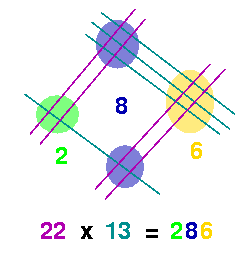
Here’s a way to multiply numbers visually!
Suppose you want to multiply 22 by 13. Draw 2 lines slanted upward to the right, and then move downward to the right a short distance and draw another 2 lines upward to the right (see the magenta lines in Figure 1). Then draw 1 line slanted downward to the right, and then move upward to the right a short distance and draw another 3 lines slanted downward to the right (the cyan lines in Figure 1).
Now count up the number of intersection points in each corner of the figure. The number of intersection points at left (green-shaded region) will be the first digit of the answer. Sum the number of intersection points at the top and bottom of the square (in the blue-shaded region); this will be the middle digit of the answer. The number of intersection points at right (in the yellow-shaded region) will be the last digit of the answer.
This will work to multiply any two two-digit numbers, but if any of the green, blue, gold sums have 10 or more points in them, be sure to carry the tens digit to the left, just as you would if you were adding.
Presentation Suggestions:
First do simple examples like the one above; then try a problem that involves a carry, such as 21 x 34.
The Math Behind the Fact:
The method works because the number of lines are like placeholders (at powers of 10: 1, 10, 100, etc.), and the number of dots at each intersection is a product of the number of lines. You are then summing up all the products that are coefficients of the same power of 10. Thus the in the example
22 x 13 = ( 2*10 + 2 ) * ( 1*10 + 3 ) = 2*1*100 + 2*3*10 + 2*1*10 + 2*3 = 286.
The diagram displays this multiplication visually. In the green-shaded region there are 2*1=2 dots. In the blue-shaded region there are 2*3+2*1=8 dots. In the gold-shaded region there are 2*3=6 dots. This method does exactly what you would do if you wrote out the multiplication the long way and added the columns!
The method can be generalized to products of three-digit numbers (or more) using more sets of lines (and summing the dot groupings vertically and remembering to carry when needed). It can also be generalized to products of three-numbers using cubes of lines rather than squares! (Of course, it gets pretty unwieldy to use the method at that point.)
By the way, for the specific problem 22 x 13 there is actually another way to do it using lightning arithmetic; can you figure out how?
How to Cite this Page:
Su, Francis E., et al. “Visual Multiplication with Lines.” Math Fun Facts. <https://www.math.hmc.edu/funfacts>.
Fun Fact suggested by:
Francis Su

